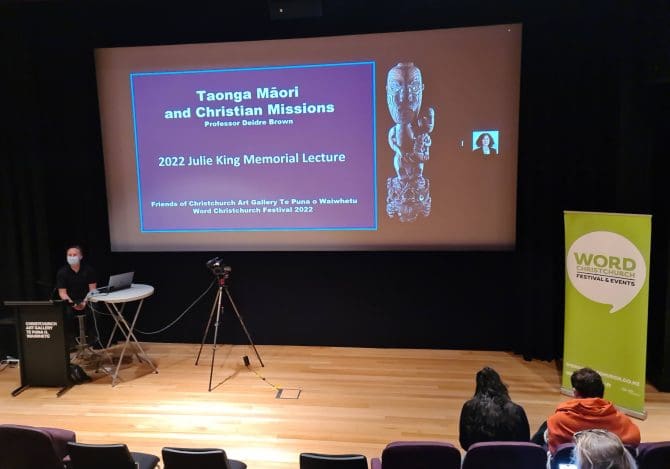Julie King Memorial Lecture: Taonga Māori & Christian Missions
Te Puna Waiwhetū | Christchurch Art Gallery
Sunday 4 September 2 to3pm
The Julie King Memorial Lecture is an annual event established in the memory of art historian and long-time supporter and patron of the Friends of Christchurch Art Gallery – Julie King. King was a long-time respected and loved Arts History lecturer at the School of Fine Arts, University of Canterbury for nearly 20 years, retiring in 2004. It was during her later years that she worked with (then) Dr Deidre Brown (Ngā Puhi, Ngāti Kahu).
I had the good fortune to be one of Brown’s first Māori Art History students in the first two years of her appointment. My introduction to her was via the Māori Department. A buzz with her arrival, I was told that she, Brown, was the first Māori woman to graduate with an architectural PhD with distinction in 1997, which, to be honest, was no mean feat. A little in awe of this reputation, I remember arriving to her first lecture and taking my seat with a little trepidation. To be honest I don’t know who I expected to stand in front of the lectern, but it certainly wasn’t this seemingly shy, unassuming, quietly spoken, very humble, pretty woman who suddenly appeared, introducing herself as Dr Deidre Brown, our lecturer! She had our attention. Over the course of the next two years her lectures were populated with Māori art practitioners, kaumātua and even the odd art school student. Whether intentional or not her lectures were conducted wānaka style where she freely encouraged discussion regarding thought provoking art work or forms and even calling on the knowledge from the repositories she knew sat in her room.
Brown returned north in 2003 taking up a post at the University of Auckland in the School of Architecture and Planning. In 2019 she became the first Māori Professor of Architecture, Head of School of Architecture, delivering her inaugural professorial lecture in mid-November 2019 entitled Ngā Toi Mōrehu: The arrival, survival and Revival of Māori art and architecture. Her reflection of 25 years of exploring “how whenua and tikanga are manifested in our buildings and objects are manifested in our buildings and objects, in periods of strength and in times when those principles are under threat.”(Brown, 2019) Her love of Māori art history and architecture has led her to author or co-author nine books. Her ninth being Toi Te Mana: A history of indigenous art published August 2021. Co-authored with the late Professor Jonathan Mane-Wheoki and Dr Ngarino Ellis of the Faculty of Arts, this book is the first comprehensive survey of Māori art from our tīpuna to present day. With up to 500 images and 200,000 words it is certainly a stunning accomplishment.
It is from this work that Brown drew her material for this lecture, Taonga Māori and Christian Missions. Unfortunately due to COVID Professor Deidre Brown joined us in the Philip Carter Family Auditorium, Christchurch Art Gallery via Zoom. That being said it did nothing to diminish her charisma, natural story-telling ability and aptitude to draw you into you into her narration. As I sat in the full auditorium I was unexpectedly transported back to my Varsity days, feeling the sudden need to take copious amounts of notes.
Over the next hour Brown revealed to us not only the role nineteenth-century Christian missions to Aotearoa played in collecting taonga Māori, but how they were distributed and understood in Western Europe, influencing Europeans perception of Māori art and society. While discussing missionary Thomas Kendall’s involvement in sending consignments of taonga Māori to the Christian Missionary Society (CMS) Museum, Brown noted that one consignment reportedly never arrived. Added to this, with the close of the CMS Museum, only a few taonga Māori were transferred to the British Museum. So where are all the hundreds of collected taonga Māori, questioned Brown?
He pātai pai te pātai – a good question. Over the past years, notwithstanding COVID, it is this question and Brown's desire to find, restore the stories of these objects and perhaps one day repatriate them back to the places they came from, that is the basis of her current research.
Building on the work of the late Dame Judith Binney, Brown has begun the mammoth task of identifying and locating these missing pieces. Some of which she has traced back to the Oldman Collection of Polynesian Artefacts which the New Zealand Government purchased 1948. That being said the work goes on and Brown is to be commended for her commitment to the task.
At the conclusion of the lecture I pondered the points raised and while it can be argued that acquisition of the taonga from Māori is a tale of entrepreneurship for Māori and survival for early missionaries, I still question how so many taonga Māori found their way offshore. Perhaps in time all will be revealed, but until then I congratulate and thank Professor Deidre Brown for her work. It is such work that helps us, as a nation, reclaim our history
More work by Professor Deidre Brown:
- Māori Architecture – from fale to wharenui and beyond
- Does Māori Art History Matter?
- Tai Tokerau Whakairo Rākau – Northland Māori Wood Carving
- Introducing Māori Art
My thanks to Nic Low, WORD and Friends of Te Puna o Waiwhetū | Christchurch Art Gallery for providing this opportunity to attend this lecture. A sincere thanks to Professor Deidre Brown for sharing her love of Māori art history with us, as always it was very insightful and left us with much to ponder on the journey home.
WORD Christchurch Festival 2022 Coverage
Visit our page of WORD 2022 Festival coverage and info
WORD Christchurch information
- Visit the WORD Christchurch website
- Follow @wordchch on Twitter
- Like @wordchch on Facebook
- Follow @wordchch on Instagram




Add a comment to: Julie King Memorial Lecture: Taonga Māori & Christian Missions